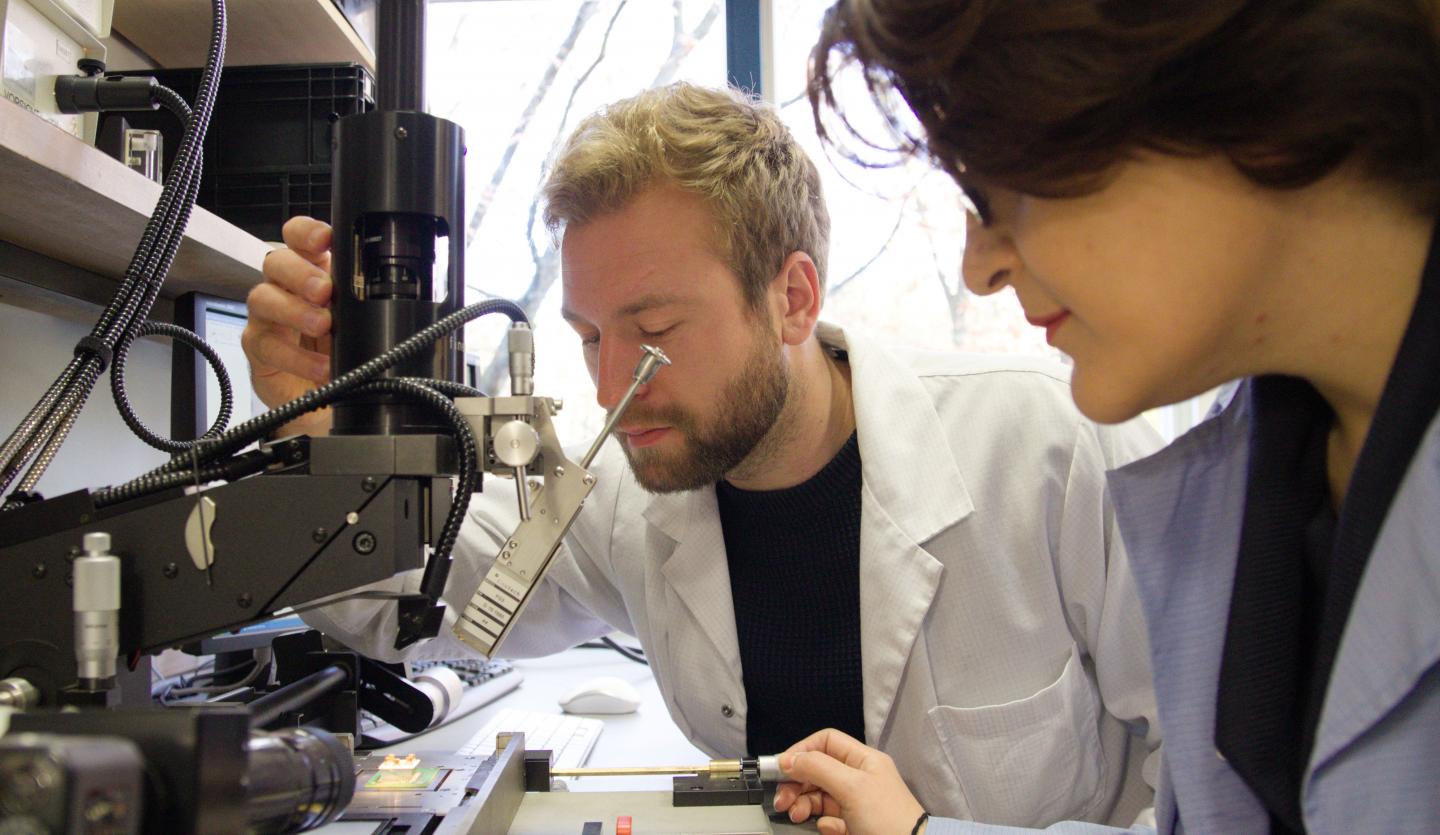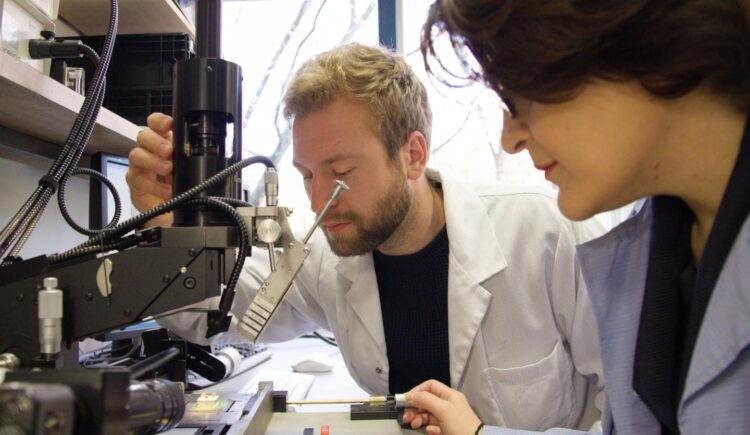DFG and FhG fund project to transfer KIT’s scientific findings to industry

Credit: Photo: Joachim Hebeler, KIT
Radar systems have long been used on aircraft or ships. Now, they are increasingly applied in cars for the “short range” in particular. Thanks to the great progress achieved in semiconductor technology in the past years, another miniaturization step is now possible. For this, researchers of Karlsruhe Institute of Technology (KIT), in cooperation with the Fraunhofer Institute for Applied Solid State Physics (IAF) in Freiburg and the industry partner VEGA Grieshaber KG, develop highly compact radar sensors of modular design that are excellently suited for various applications in industry.
A so far unmatched resolution can be reached by radar sensors, in which antennas can be integrated in chips or in the chip housing due to the small wavelength. However, frequencies above 100 GHz have hardly been used so far, as this requires extremely complex mounting and connection technologies. For a long time, this has limited production of inexpensive integrated modules.
Now, models developed in the project “Real100G.RF” funded by the German Research Foundation (DFG) are combined with circuits made by Fraunhofer IAF. The resulting scalable miniaturized radar front end will then be evaluated for industrial use by the VEGA Company from Schiltach in the Black Forest.
This project “Skalierbares THz-Miniaturradar für Industrieanwendungen” (SATIRE, Scalable THz Miniaturized Radar for Industrial Applications) is one of six trilateral projects funded by DFG and Fraunhofer Society (FhG). All of them are aimed at transferring scientific findings to industry. Within the trilateral project SATIRE, companies can participate at an early stage in innovations made by research.
“KIT is a unique institution in Germany and works in an extraordinarily wide range of research fields. The focus lies not only on research and academic education, but also on innovations, which means that science and industry cooperate and complement and enrich each other,” says Theresia Bauer, Baden-Württemberg Minister of Science, Research, and the Arts. “For this reason, I am very happy about the funding of the KIT transfer project by DFG and Fraunhofer Society. Here, promising research is directly transferred to application. Funding once again reflects the high importance of universities and research institutions in Baden-Württemberg beyond our state borders.”
Focus on Miniaturization
The SATIRE project is aimed at developing a scalable, highly integrated 300 GHz radar sensor with a bandwidth above 50 GHz and a resolution in the millimeter range. The modules, including lens, have a maximum dimension of 10 mm x 10 mm x 7 mm and can be connected to form a MIMO system (multiple input multiple output, method for the use of several transmitting and receiving antennas for wireless communication) or applied individually on a board. This makes the modules particularly suited for industrial sensors. “The project also uses technical resources of the Research Laboratory Microelectronics Germany of KIT,” says the President of KIT, Professor Holger Hanselka. “On a par with research and education, innovation at KIT reflects the application-oriented character of research and development. This innovative capacity bridges the gap between findings and application.”
Radar sensors at frequencies above 100 GHz have a great potential in complementing existing optical sensors, such as cameras or lidars. “They reach a good resolution and are highly robust, e.g. against smoke or dust,” says Professor Thomas Zwick, project coordinator and Head of KIT’s Institute of Radio Frequency Engineering and Electronics (IHE). To reach a resolution in the millimeter range, the circuit must have an output bandwidth of at least 50 GHz with a switchable transmitter for TDM-MIMO operation (TDM stands for Time Division Multiplex, a method for signal transmission). For this purpose, lenses made of ceramics and of a polymer are tested, 3D printing and injection molding are applied. The complete component will be as large as the lens, maximum dimensions will amount to 10 mm. “With our mini radar, we will not only improve measurement performance, but also industrial manufacturability,” Zwick points out. The small size and precise measurement open up entirely new applications. Moreover, the architecture with multipliers, an external local oscillator, and a switchable transmitter enables interconnection of several radar sensors to form a MIMO radar on the board.
The resulting radar front end can be used for various industrial applications and can be scaled to various systems. The project is of high practical relevance. Companies – here, VEGA – are given the opportunity to participate in innovations from research at an early stage.
###
The SATIRE Project
The six projects, in which universities, Fraunhofer institutes, and industrial companies cooperate with each other, are funded by DFG and Fraunhofer Society for three years with a total of about 5 million euros. Coordinators of the SATIRE project (Scalable THz Miniaturized Radar for Industrial Applications) are Professor Thomas Zwick from KIT and Dr. Arnulf Leuther from the Fraunhofer Institute for Applied Solid State Physics (IAF), Freiburg. The industry partner is VEGA Grieshaber GK, Schiltach.
Press contact:
Johannes Wagner
Press Officer
Phone: +49 721 608-41175
Email: [email protected]
Being “The Research University in the Helmholtz Association”, KIT creates and imparts knowledge for the society and the environment. It is the objective to make significant contributions to the global challenges in the fields of energy, mobility, and information. For this, about 9,300 employees cooperate in a broad range of disciplines in natural sciences, engineering sciences, economics, and the humanities and social sciences. KIT prepares its 24,400 students for responsible tasks in society, industry, and science by offering research-based study programs. Innovation efforts at KIT build a bridge between important scientific findings and their application for the benefit of society, economic prosperity, and the preservation of our natural basis of life. KIT is one of the German universities of excellence.
This press release is available on the internet at http://www.
Media Contact
Monika Landgraf
[email protected]
Original Source
https:/





